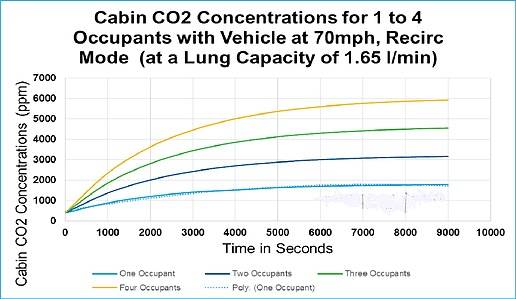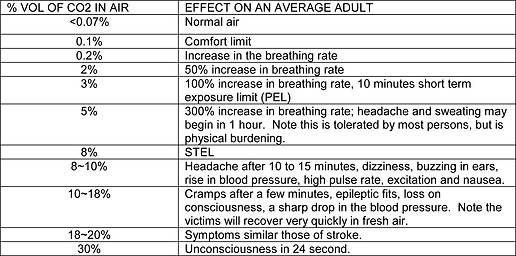 在车上有4个人的情况下,车舱内的CO2水平将在短短1.5小时内增加至0.6% (6000 ppm)的水平。
在车上有4个人的情况下,车舱内的CO2水平将在短短1.5小时内增加至0.6% (6000 ppm)的水平。 当人们在炎热天气下的选择“Max A/C”模式,即空调开到最大时,车辆的HVAC空调将隔绝车辆的内外空气流通。
当人们在炎热天气下的选择“Max A/C”模式,即空调开到最大时,车辆的HVAC空调将隔绝车辆的内外空气流通。 车内二氧化碳水平及其对乘客的影响。
车内二氧化碳水平及其对乘客的影响。
一些小型封闭区域,比如车内的CO2积聚,可能给乘客带来潜在健康威胁。多年以来,绝大多数车辆空调系统的外部空气吊门均采用了缺口设计,因此还有一些“新鲜”空气可以进入车内。而且即使没有缺口,由于车身的密封性本身相对较差,而且乘客无法关闭送风开关(最低只能调至低速净化模式),因此车内空气问题并非如此严峻。
然而,为了进一步优化空调性能,一些较新款车型已经可以关闭空气循环(或开至Max A/C档位),隔绝外部空气进入车内。目前,这种措施甚至还可以作为一种燃料经济性优化手段,在美国EPA的燃料经济评分中获得加分。无论如何,哪怕仅仅为了乘客的舒适度,在一些温度较高的州内,直接隔绝车内空气流通的情况非常常见。
当人们在炎热天气下的选择“Max A/C”模式,即空调开到最大时,车辆的HVAC空调将隔绝车辆的内外空气流通。
为满足舒适度要求,CO2含量不得超过0.1%
不过,这种做法将给车舱内的空气质量带来显著影响,CO2积聚将影响乘客的呼吸系统健康。正如康奈可(Calsonic Kansei)北美公司高级测试研发经理G.D.Mathur博士在WCX17 – SAE 2017全球汽车年会上的发言中所指出的,为了保证乘客的舒适度,车内的CO2浓度不能超过0.1%。按照美国环保署目前的规定,车内的CO2浓度在短时间内(15分钟)的积聚浓度不得超过3%,最大不得超过4%。但事实上,环保署的此项规定是专门针对使用R-744空调系统(CO2为制冷剂)的车型,主要目的也是为了判断车辆是否存在CO2制冷剂泄露,而非由乘客呼吸引起的CO2积聚。
美国供暖制冷空调工程师学会(American Society Heating, Refrigeration and Air ConditioningEngineers, ASHRAE)表示,环境中的CO2浓度通常为400 ppm,而为了保证舒适度,车舱内的CO2浓度不应超过环境浓度以上700 ppm,也就是说车内的CO2浓度最高不得超过1100 ppm (0.11%)。
CO2传感器可以用于监测车内的CO2浓度积聚,但汽车行业更多将这种设备用作一种定时措施(比如10到20分钟循环一次)。然而,汽车厂商还需要保证最大循环,从而满足EPA的要求,拿到相应的得分。
Mathur认为,尽管行业已经针对该领域进行了一些建模和极限测试,但为了充分覆盖车辆老化带来的影响,我们还需要更多、更好的数据。通常来说,大多数新车的车门和车窗边缘均采用了三重密封设计,但密封效果将随着时间的推移而退化。研究人员可以针对车上人员数量、车内空间大小、空气泄露情况和出风口流量等因素,建立CO2积聚模型。不过,车内人员的活动状态也会对CO2的积聚带来很大影响,比如几位乘客都保持安静,和父母大声管教孩子,这两种情景下的CO2水平肯定不同。
此外,不同乘客的肺活量也存在较大差异,一些围绕R-744空调系统的研究显示,人类呼吸系统产生的CO2在3.8%到5.8% (38,000-58,000 ppm)之间。Mathur已经将人员的平均肺活量量化为1.65升/分钟,他说这个水平也与自己之前的研究相一致。实验表明,车内的CO2浓度在短短4到5分钟内即会达到1,100 ppm,也就是超过舒适范围。这也就是说,对于行程超过500英里/800公里的长距离行车来讲,8小时的旅程很可能让车内的CO2浓度到达到危险水平。
CO2对车祸的影响
Mathur指出,美国亚利桑那州交通运输部已经记录了多起因CO2浓度积聚引起的交通致死事故。这个判断是通过遇难者的血液检测得出的。
Mathur表示,虽然他没有具体的数据,但该研究还需要考虑一氧化碳 (CO)对结果的可能影响。他观察到,当车舱内没有正压时,CO很容易通过车辆的排气和底部接缝进入车舱,具体水平根据具体车型及相应排气系统有很大差异。不过,一旦CO浓度达到30 ppm,就有可能导致乘客头痛。
在Mathur的演讲之前,SAE室内气候控制标委会(SAE Interior Climate Control Committee)也在最近一次会议上讨论了相关问题,并呼吁成立专门工作小组。该工作小组将仅关注车上人员的呼吸产生的CO2问题,而非R-744系统可能发生的泄露问题。参与人员将针对汽车内部空间大小、乘客数量、空气交换率、驾驶循环及发动机熄火/闲置等条件下的可接受CO2浓度达成共识。相关测试将在一个CO2气缸中完成,具体设计将根据不同车辆的传感器和空调设置而进行调整。
High carbon dioxide concentration in a small area, such as a passenger car cabin, is a health hazard. For many years the outside air flap door on most HVAC systems was notched, so that in recirculation there was some “fresh” air flowing into the cabin. Even without the notch, the car body was relatively leaky and the blower switch didn’t have an off position, only a low speed to purge stale air.
To improve A/C performance, the recirculation switch (or Max A/C position on HVAC switch) in newer cars permits shutting off outside air. Now there’s even a U.S. EPA fuel economy credit because this approach improves A/C fuel economy. However, just for passenger comfort, in states with high ambient temperatures, shutting off outside air is common.
Comfort level just 0.1%
This has an obvious effect on passenger compartment air quality, and CO2 buildup from human respiration can affect passengers. As Dr. G.D. Mathur, senior manager for test and development at CalsonicKansei North America, pointed out in a 2017 SAE World Congress (WCX17) presentation, just 0.1% concentration is the comfort limit. EPA’s short term exposure limit (15 min) of 3% and a maximum exposure of 4% in the breathing zone was promulgated only for R-744 air conditioning (carbon dioxide used as a refrigerant), to cover a large leak, not a human-caused buildup.
ASHRAE (American Society Heating, Refrigeration and Air Conditioning Engineers) says the comfort limit for CO2 concentration is 700 ppm over the ambient level, which is approximately 400 ppm, for a total of 1100 ppm (0.11%).
CO2 sensors provide one avenue for automotive control, but more likely is the timed approach used by some car manufacturers (10-20 minutes at a time in recirculation). However, there is a need to maintain maximum recirculation to meet the intent of the EPA credits.
For all the modeling and the limited testing that has been done in this area, Mathur noted that better data is needed to cover vehicle ageing. Most new vehicles start life with triple sealing of the doors and glass areas, but seals deteriorate over time. A researcher can model CO2 buildup based on number of passengers against cabin volume, air leakage and blower flow rate. However, there is great variability in exhalation CO2 for passenger activity level (sitting quietly vs. parent screaming at youngster in high activity, for example).
There also is a major difference in human lung capacity, and work on R-744 air conditioning systems has led to studies on that subject, showing a range of 3.8% to 5.8% CO2 (38,000-58,000 ppm) in human respiration. Mathur’s research led him to quantify lung capacity at 1.65 L/min, which he said matched well with previous work he had performed. It indicates a buildup to 1100 ppm –just over the comfort level—within the first 4-5 min of a simulated test drive. With a vehicle range of over 500 mi/800 km, an eight-hour trip can raise CO2 concentration to dangerous levels.
CO2 effect on car crashes
Mathur noted several deaths recorded by the Arizona Dept. of Transportation were blamed on crashes from CO2 buildup affecting the driver. The attributions were validated by blood analysis of the crash victims, indicating the issue is real world.
Although he had no specific data, Mathur said that research also needs to consider possible contributions from carbon monoxide (CO). He observed that in recirculation there is no positive pressure in the cabin, so with exhaust and underbody seams leakage, CO can penetrate. The level would be subject to great variability based on the exhaust system and car. If it reaches a level of 30 ppm, it is likely to cause passenger headaches.
Prior to Mathur’s presentation, the SAE Interior Climate Control Committee had discussed this subject at its last meeting and a call was issued for a working group. The purpose was described as to focus only on occupants respiration, not leakage from an R-744 system. Participants would agree on vehicle interior volume, passenger volume, air exchange rate, drive cycle, also engine off and at idle. Testing would be performed with a CO2 cylinder, and specific settings for vehicle sensors and HVAC operation, including possible preconditioning.
Author: Paul Weissler
Source: SAE Automotive Engineering Magazine
等级
打分
- 2分
- 4分
- 6分
- 8分
- 10分
平均分
